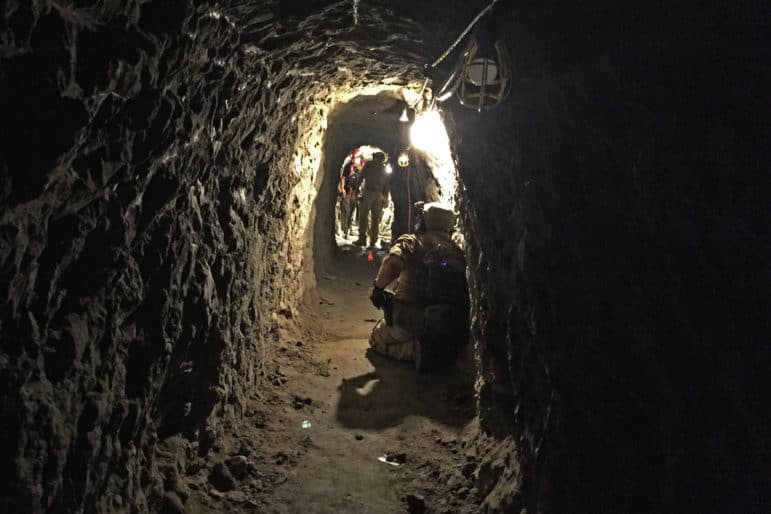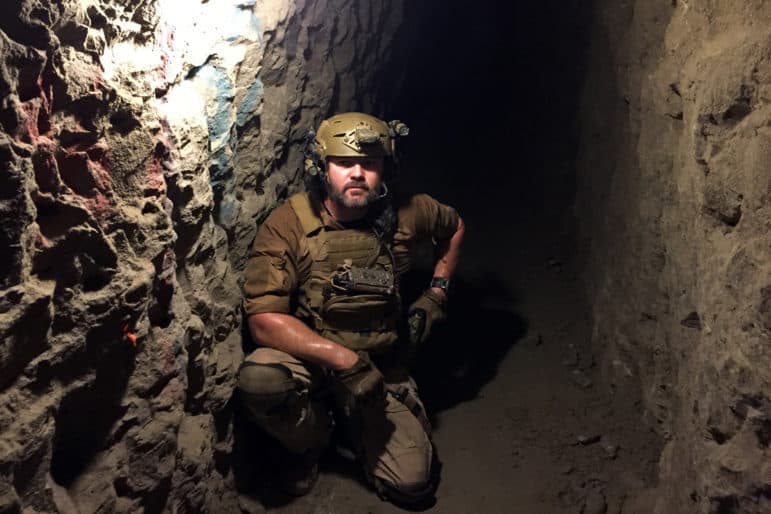
Sarah Tory / for High Country News
The Galvez Tunnel has remained open for tours and training since 2009. Many other tunnels have been blocked on the U.S. side but remain open on Mexican land.
On a recent Friday in October, Tekae Michael, a Border Patrol agent who handles public affairs, drove a large SUV along the towering corrugated metal fence that marks the U.S.-Mexico border near Otay Mesa, an industrial area southeast of San Diego. To her left lay another fence, topped with concertina wire, creating a 14-mile corridor complete with stadium lighting, hidden motion sensors and surveillance cameras that lent the border an atmosphere of impenetrability.
But appearances can be deceiving. Michael pointed to where cuts had been made near the bottom of the secondary fence. Dense fog poses another challenge, she added. “It only takes a minute to get over, and then you can just vanish.”
It’s one thing to build a wall — or reinforce an existing one — to secure the border above the ground. But how do you secure the ground beneath it? There, Michael admitted, the border looks more like Swiss cheese. Since the early 1990s, 65 tunnels have been discovered in the Otay Mesa area, mostly built for drug trafficking. But human smugglers sometimes use existing storm drains to ferry migrants across, too. In the U.S., finding and dismantling those tunnels (the “subterranean threat” in Border Patrol lingo) falls to a little-known group of agents within the agency — the Confined Spaces Entry Team, or simply, the Tunnel Rats.
The agents struggle to stay ahead of the digging. On Sept. 19, Mexican officials unearthed another tunnel, starting from a private home in the town of Jacume, 60 miles east of Tijuana. Although the tunnel still lacked an exit into the U.S., it did succeed in crossing the border, despite the presence of a 16-foot-high steel bollard wall.
Sandwiched between the two border walls overlooking the warehouses of Otay Mesa, Michael hands out helmets and harnesses to a group of reporters, including me. Below us lay the Galvez Tunnel, which the Border Patrol has kept open for training and media tours since its discovery in 2009. Before the U.S. began building a wall along the Southwest border, there was little need for tunnels, Lance Lenoir, the head of the five-member Tunnel Rats team, told me. A few cables strung between wooden posts were all that marked the boundary between the two countries.
Then, “we put a fence up,” said Lenoir, whose brusque manner was tempered by the image of a cartoon rat on the back of his camel-colored shirt. Since the early 1990s, when border security tightened, an average of two cross-border tunnels have been found every year. Smugglers use them to transport ever-larger quantities of drugs into the U.S. — most successfully, the Sinaloa Cartel, whose notorious kingpin, El Chapo, masterminded the first cross-border narcotúnel from Agua Prieta to Douglas, Arizona, in 1989.
Still, Lenoir noted, enhanced border security is not the only cause for the proliferation of tunnels; the rise of cartels and a growing U.S. drug market have played a role, too. Over the years, officials have found nearly 200 tunnels along the 2,000-mile-long U.S.-Mexico border, mostly in Arizona and California. They range from rudimentary crawlspaces to “super tunnels” that cost upwards of a million dollars to build and are equipped with elevators, electric lights, and disguised exits and entrances. Lenoir refuses to describe them as sophisticated, though. “I would not want to give our enemies that kind of credit,” he told me, insisting that I write these details down in my notebook: “The only thing that’s of note when it comes to these tunnels in San Diego is their persistence and audacity.”

Sarah Tory / for High Country News
Border Patrol Agent Jeremy Wilkins inside the Galvez Tunnel.
Inside the tunnel, 70 feet underground, Lenoir pointed admiringly to the orange tubing covering the electrical wires that run along the gray sandstone walls, sculpted with chisels and jackhammers. “One of the few quasi-professional jobs I’ve seen,” he said.
Professional or not, stopping the tunnels is harder than one might expect. Like many others, the Galvez Tunnel started inside a warehouse in northern Tijuana and ended in Otay Mesa, taking advantage of the heavy truck traffic in and out of the area to help distract from unwanted attention. Working with Mexican officials to stop the tunnels is another challenge: There are fewer resources and attention devoted to the issue in Mexico. Right now, Lenoir said, “We’ve closed off these tunnels on the U.S side, but they’re completely open in Tijuana.” One time, after experiencing a feeling of déjà vu, he found himself in the same tunnel that he and his team had previously found and plugged. The builders had simply dug around what the Tunnel Rats had closed off.
Since at least the ancient Egyptians, humans have dug tunnels, and yet even with modern technology, it’s surprisingly hard to detect them. Agents can deploy small robots equipped with cameras to check for smuggling activity, and they can use sonic radar to monitor different ground densities, but mostly, they rely on tips and informants who keep tabs on the warehouses in Otay Mesa — a strategy Lenoir likened to “knowing your battlefield.”
After the hour-long tour was over, we clambered back up the ladder and emerged into the glare of the Southern California sun. Through the slats in the wall, the cars and people and buildings of Mexico were visible just a few feet away. From here, the border didn’t look like a battlefield, anymore than the wall seemed like an impenetrable barrier. In the end, it appeared, all it would take is some digging.
Sarah Tory is a correspondent for High Country News. She writes from Carbondale, Colorado. Email HCN at editor@hcn.org or submit a letter to the editor.